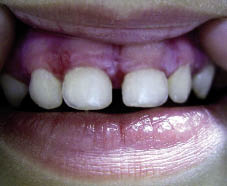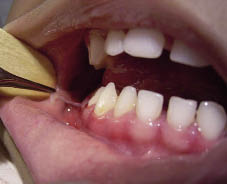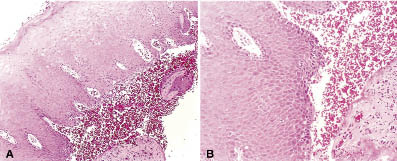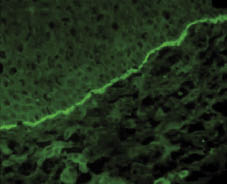Silvia V. Lourenço, Paula Boggio, Luis E. Agner Machado Martins, Cláudia G. Santi, Valeria Aoki and Marcello Menta Simonsen Nico
Department of Dermatology, Hospital das Clínicas, University of São Paulo School of Medicine, São Paulo, Brazil
Mucous membrane pemphigoid is a chronic inflammatory, bullous subepithelial auto-immune disease, with predominant involvement of the mucosal surfaces. Oral mucous membrane pemphigoid occurring in childhood is extremely rare. We describe a new case of this entity occurring in a 4-year-old girl who presented with desquamative gingivitis. Diagnosis was based on clinical presentation, histopathology, immunofluorescence and immunoblotting examinations. Treatment and 2-year follow-up are described. Key words: desquamative gingivitis; mucous membrane; oral pemphigoid; child.
(Accepted January 4, 2006.)
Acta Derm Venereol 2006; 86: 351–354.
Silvia Vanessa Lourenço, Instituto de Medicina Tropical de São Paulo, Av. Dr. Enéas de Carvalho Aguiar 500, 2º andar, Cerqueira César, CEP: 05403-000, São Paulo, SP, Brazil. E-mail: sloducca@usp.br
Mucous membrane pemphigoid (MMP), as defined in a recent consensus statement (1), consists of a heterogeneous group of auto-immune, chronic inflammatory, subepithelial blistering diseases predominantly affecting mucous membranes (oral, ocular, urogenital, anal, nasopharyngeal, oesophageal and/or laryngeal); with or without clinically observable scarring (1, 2). It is characterized by linear deposition of IgG and C3, and IgA to a lesser degree, along the epithelial basement membrane zone (BMZ). Skin is sometimes affected, in a localized and transient pattern (1–3).
The oral cavity is most frequently affected, and in many cases constitutes the single presentation of the disease (1, 4). Oral MMP typically manifests as erythematous patches, blisters, erosions and pseudomembrane-covered erosions, located mostly on attached gingivae, where it is described as desquamative gingivitis (DG) (5–7). Other oral sites, such as palate, lips, tongue and buccal mucosae, can also be involved, but with a lower incidence (1, 8).
Exclusive oral MMP occurring in childhood is extremely rare (9, 10), and about six cases occurring in patients under the age of 18 years have been reported so far in the English literature. We describe here a new case of this entity presenting as DG in a 4-year-old girl.
CASE REPORT
A 4-year-old Brazilian girl presented with a 2-year history of gingival tenderness and soreness, associated with moderate pain and bleeding during tooth brushing. She had been submitted to professional dental hygiene procedures without improvement.
Clinical examination revealed erythema, oedema and erosions on attached gingival surfaces of both the maxilla and the mandible, in the area of the canines and molars (Fig. 1). Gentle friction applied to the involved gingival area resulted in formation of blood-filled bullae and the covering epithelium was easily removed with forceps (Fig. 2). There was no evidence of scarring. Symptoms related to other mucosal sites or cutaneous lesions were not verified. Cervical lymph node enlargement was detected. Apart from this, the patient was in good health and was taking no medication. Full blood count, erythrocyte sedimentation rate, electrolytes, renal and liver function tests were normal. Family history was non-contributory.
Fig. 2. Epithelium detachment (arrow) when pulled off with forceps.


Fig. 1. Desquamative gingivitis on arcades gingival surfaces.
Biopsies from lesional and peri-lesional gingival tissues were sent for histopathological and immunofluorescent studies. At microscopy the specimens showed subepithelial detachment with a moderate mixed infiltrate in the lamina propria (Fig. 3). Direct immunofluorescence (DIF) revealed strong linear band deposits of IgG and C3 at the epithelial BMZ (Fig. 4). Circulating anti-BMZ antibodies were not detected by indirect immunofluorescence performed on salt-split skin. Immunoblotting was performed using total epidermal extracts, recombinant BP180 (NC16A) and recombinant collagen VII; the results were negative with all these substrates.

Fig. 3. Subepithelial cleavage with basal layer preservation. (A) H&E ×40 original magnification. (B) H&E ×100 original magnification.
Fig. 4. Direct immunofluorescence: linear deposits of IgG and C3 at oral mucosal basement membrane zone.

Taking into account the constellation of clinical, histopathological and immunological findings, the case was diagnosed as MMP. Additional evaluation discarded extra-oral involvement; however, the patient is still under ophthalmological surveillance.
Treatment was initiated with 50 mg of dapsone daily. During the first year of follow-up she maintained the same dapsone regimen with occasional mild DG. Dapsone was then slowly tapered and discontinued after a 20-month treatment. The patient has since been free of disease for 4 months.
DISCUSSION
The compilation of clinical findings such as erosion, bullae and easily detachable epithelium on traction, combined with histopathological findings and immunological studies supported the diagnosis of MMP in this 4-year-old girl with DG.
The disease usually affects middle-aged or elderly females (2, 7–11, 12). It can manifest as erosions of the non-keratinized mucosa or desquamation of the keratinized mucosal areas. Scarring, an important feature of MMP, is not often seen in the oral mucosae (1, 2, 5, 8, 12).
There are only 13 cases of childhood MMP reported in the English literature (Table I), 6 of them diagnosed as oral MMP (4, 9, 10, 12–14). Interestingly, in all except one, DG was the main clinical manifestation.
| Table I. Reported cases of childhood oral mucous membrane pemphigoid and subepitelial blister formation at light microscopy (1978–2005) | |||||||
| Gender/age (years) | |||||||
| Gender/age (years) | F/18 | F/14 | M/13 | F/14 | F/8 | F/9 | F/4 |
| Clinical presentation | DG (?) | DG | DG | DG | DG | NUG | DG |
| Time before diagnosis | 2 months | 2 years | 1 years | 4 months | 6 months | 9 months | 2 years |
| DIF | IgG/C3 | IgG/IgA/C3 | IgG/C3 | IgG/C3/fibrin | IgG/C3 | C3 | IgG/C3 |
| IIF | 1:32 | –ve | –ve | –ve | –ve | NP | –ve |
| Treatment | Topical steroids | Topical steroids | Topical/ systemic steroids | Topical steroids | Topical steroids | Topical steroids | Dapsone |
| Follow-up | 8 months | 3 years | 1 years | 18 months | 7 months | 2 years | 2 years |
| Remission | Yes | Yes | Yes | Minimal activity | Yes | Non-compliance | Yes |
| Year (Ref.) | 1978 (13) | 1988 (4) | 1990 (9) | 1997 (10) | 2000 (12) | 2002 (14) | Present study |
F, female; M, male; DG: desquamative gingivitis; NUG: necrotizing ulcerative gingivitis; –ve: negative; DIF: direct immunofluorescence; IIF: indirect immunofluorescence; NP: not performed.
DG, a condition first reported by Tomes in 1897 (5, 6), is a clinical description of an erythematous and “polished apparent” gingivae, covered with a white friable membrane that peels-off with minimal trauma, leaving an underlying denuded surface (5, 6, 8). Gentle trauma of apparently non-affected mucosa may induce bullae and/or desquamation, with tags of detached epithelium (2, 6, 8, 15). DG affects attached gingivae, generally sparing the marginal one, and does not improve with oral hygiene measures or periodontal therapy alone (2, 8). Pain of variable intensity or burning sensation may be the chief complaint (5, 6).
DG may be a clinical manifestation of several underlying diseases (2, 4, 5, 9, 15, 16). Most DG cases are related to MMP or lichen planus, while a small number correspond to pemphigus vulgaris (5, 9, 16). Sklavounou & Laskaris (15) studied 111 patients with one of the following diseases: MMP, pemphigus vulgaris or bullous pemphigoid (BP) presenting with DG, and found that 64% of them were consistent with MMP. Other series reported DG in approximately 55% of patients diagnosed as MMP (17). Less frequently, other conditions, such as linear IgA disease, dermatitis herpetiformis, erythema multiforme and plasma cell gingivitis, may also present with DG (2, 12, 16).
The diagnosis of MMP requires the association of clinical aspects with histopathological and immunofluorescence analysis of biopsied lesions (1, 9). Our patient presented clinically with DG, which is unusual in a patient of this age. Histopathological findings and DIF supported MMP diagnosis, despite indirect immunofluorescence examination failed to detect circulating antibodies. According to the First International Consensus on Mucous Membrane Pemphigoid (1), results of light microscopy analysis are not an absolute criterion for the establishment of the final diagnosis, however, subepithelial blisters with or without inflammatory infiltrate are seen in most specimens (1). Detection of linear BMZ deposits of IgG, IgA or C3 by DIF is putative to demonstrate the auto-immune nature of this condition, although this examination does not distinguish MMP from BP, linear IgA dermatosis and epidermolysis bullosa acquisita (1). Indirect immunofluorescence, preferably performed on salt-split skin, may show variable patterns reflecting the various auto-antigens recognized by these patient’s auto-antibodies (1). Most patients with MMP have antibodies that bind to the epidermal side of salt-split skin, while a minor group presents antibodies (probably anti-laminin-5) that bind to the dermal side of salt-split skin. Mixed deposits (on both dermal and epidermal sides of salt-split skin) have also been described (8). Indirect immunofluorescence detection rates in MMP range between 50% and 80%, so the lack of positivity of this examination is not an exclusion criterion for MMP (1, 8). Immunoblotting is an additional method for identification of auto-antigens involved in the pathogenesis of bullous diseases. In MMP cases, a broad variety of molecules located at BMZ have been implicated, such as BP 180, laminin 5, laminin 6, α6-β4 integrin, amongst others (1, 8). In the present case, immunoblotting was negative utilizing total epidermal extracts, recombinant BP 180 and collagen VII, reducing the possibility of BP and epidermolysis bullosa acquisita. However, the absence of our patient’s serum reactivity with total epidermal extract does not exclude MMP, since some antigens may be lost during extract preparation (18, 19). Other antigens that could be implicated in this case rather than BP 180 or collagen VII, were not available.
Treatment of MMP is difficult (1). Potent topical corticosteroids are indicated for mild and localized cases (20). In severe disease, refractory cases or uncontrolled flares, dapsone is the first-line therapy at daily doses of 1.5–2 mg/kg (21). Oral steroids as well as other immunosuppressive agents constitute second-line options (10, 20). Dapsone was chosen as the initial therapy for our patient, taking into account age and the clinical characteristics of the lesions (localized but longstanding).
Prognosis of oral childhood MMP is good, although long-term follow-up is recommended (2, 12). Ophthalmological surveillance is needed, as ocular lesions may appear several years after disease onset, leading to blindness in some cases (1, 2, 10).
Early diagnosis of MMP may avoid severe and irreversible involvement of other mucous membrane sites. Professional groups involved in oral care should bear in mind this rare entity regardless of patient’s age, in order to refer these patients to appropriate specialists.
REFERENCES
1. Chan LS, Ahmed AR, Anhalt GJ, Bernauer W, Cooper KD, Elder MJ, et al. The first international consensus on mucous membrane pemphigoid: definition, diagnostic criteria, pathogenic factors, medical treatment and prognostic indicators. Arch Dermatol 2002; 138: 370–379.
2. Robinson NA, Wray D. Desquamative gingivitis: a sign of mucocutaneous disorders – a review. Aust Dent J 2003; 48: 206–211.
3. Wojnarowska F, Marsden RA, Bhogal B, Black MM. Childhood cicatricial pemphigoid with linear IgA deposits. Clin Exp Dermatol 1984; 9: 407–415.
4. Laskaris G, Triantafyllou A, Economopoulou P. Gingival manifestations of childhood cicatricial pemphigoid. Oral Surg Oral Med Oral Pathol 1988; 66: 349–352.
5. Nisengard RJ, Neiders M. Desquamative lesions of the gingiva. J Periodontol 1981; 52: 500– 510.
6. Fine RM, Weathers DR. Desquamative gingivitis: a form of cicatricial pemphigoid? Br J Dermatol 1980; 102: 393–399.
7. Silverman S. Jr, Gorsky M, Lozada-Nur F, Liu A. Oral mucous membrane pemphigoid. A study of sixty-five patients. Oral Surg Oral Med Oral Pathol 1986; 61: 233– 237.
8. Fleming TE, Korman NJ. Cicatricial pemphigoid. J Am Acad Dermatol 2000; 43: 571–591.
9. Sklavounou A, Laskaris G. Childhood cicatricial pemphigoid with exclusive gingival involvement. J Oral Maxillofac Surg 1990; 19: 197–199.
10. Roche C, Field EA. Benign mucous membrane pemphigoid presenting as desquamative gingivitis in a 14-year-old child. Int J Paediatr Dent 1997; 7: 31–34.
11. Kurihara M, Nishimura F, Hashimoto T, Koami A, Hueda H, Kokeguchi S, et al. Immunopathological diagnosis of cicatricial pemphigoid with desquamative gingivitis. A case report. J Periodontol 2001; 72: 243–249.
12. Cheng YS, Rees TD, Wright JM, Plemons JM. Childhood oral pemphigoid: a case report and review of the literature. J Oral Pathol Med 2001; 30: 372– 377.
13. Worsaae N, Dabelsteen E. Benign mucous membrane pemphigoid in an 18-year-old woman. Arch Dermatol 1978; 114: 1093–1094.
14. Musa NJ, Kumar V, Humphreys L, Aguirre A, Neiders ME. Oral pemphigoid masquerading as necrotizing ulcerative gingivitis in a child. J Periodontol 2002; 73: 657–663.
15. Sklavounou A, Laskaris G. Frequency of desquamative gingivitis in skin diseases. Oral Surg Oral Med Oral Pathol 1983; 56: 141–144.
16. Mignogna MD, Lo Muzio L, Bucci E. Clinical features of gingival pemphigus vulgaris. J Clin Periodontol 2001; 28: 489–493.
17. Laskaris G, Demetriou N, Angelopoulos A. Immunofluorescent studies in desquamative gingivitis. J Oral Pathol 1981; 10: 398–407.
18. Bernard P, Prost C, Lecerf V, Intrator L, Combemale P, Bedane C, et al. Studies of cicatricial pemphigoid autoantibodies using direct immunoelectron microscopy and immunoblotting analysis. J Invest Dermatol 1990; 94: 630–635.
19. Sarret Y, Reano A, Nicolas JF, Su H, Thivolet J. Bullous pemphigoid and cicatricial pemphigoid: immunoblotting detection of involved autoantigens. Autoimmunity 1989; 2: 145–153.
20. Lorenzana ER, Rees TD, Hallmon WW. Esthetic management of multiple recession defects in a patient with cicatricial pemphigoid. J Periodontol 2001; 72: 230–237.
21. Sacher C, Hunzelmann N. Cicatricial pemphigoid (mucous membrane pemphigoid): current and emerging therapeutic approaches. Am J Clin Dermatol 2005; 6: 93–103.
